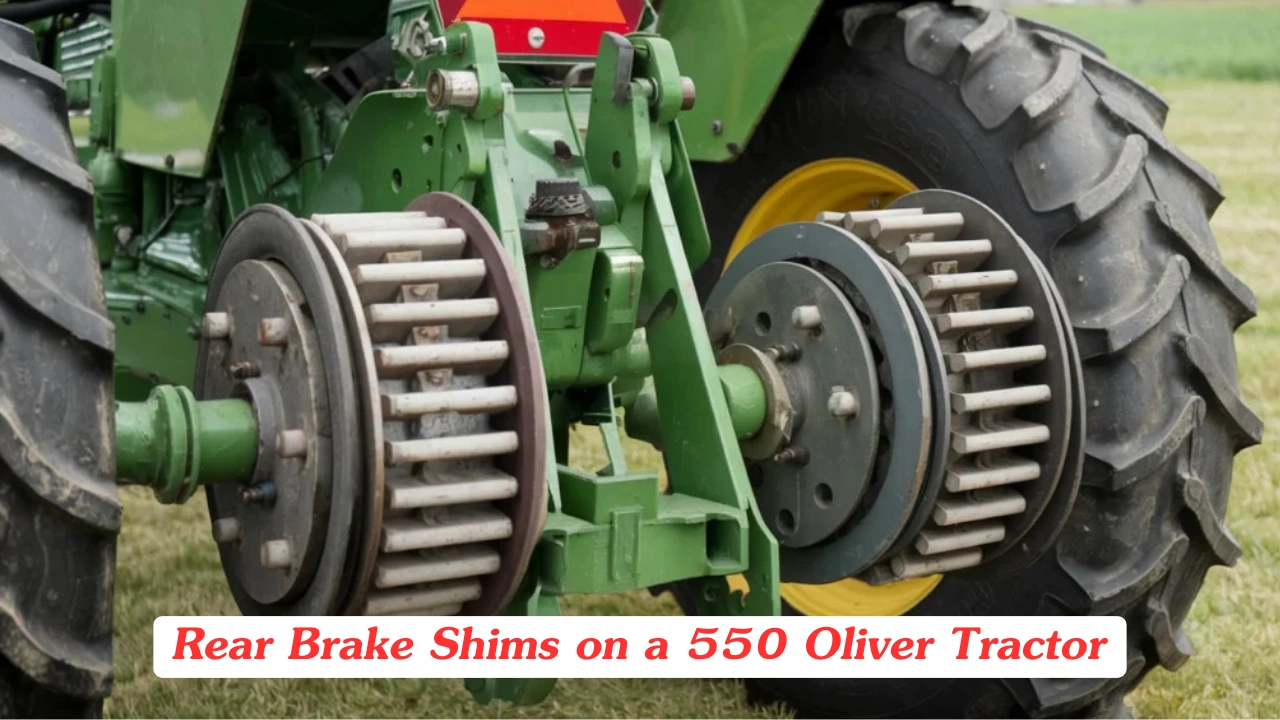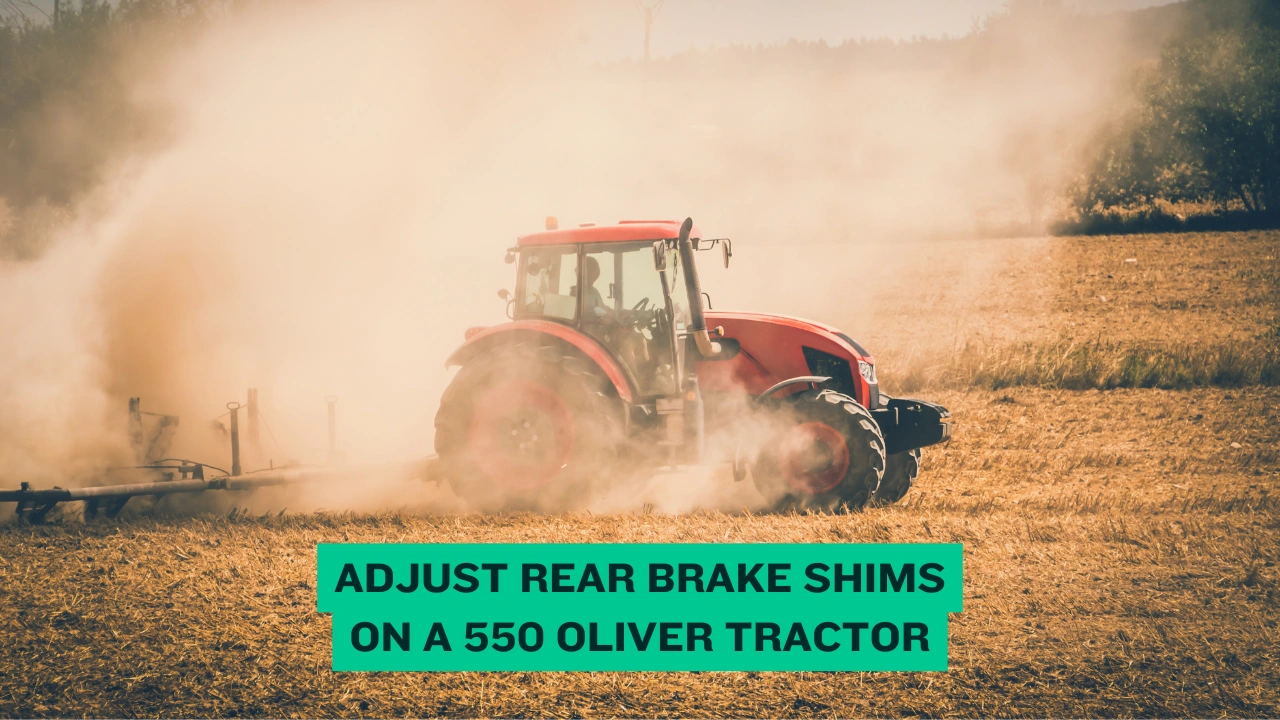Rear Brake Shims on a 550 Oliver Tractor: Common Issues and Solutions

If you own or maintain a 550 Oliver tractor, understanding the role and importance of rear brake shims is crucial. These thin metal spacers are essential for ensuring optimal braking performance and safety. Over time, the brake components of a tractor may wear down, requiring precise adjustments to maintain functionality. Rear brake shims on a 550 Oliver tractor help make those adjustments, ensuring that the braking system operates smoothly and reliably.
What Are Rear Brake Shims?
Rear brake shims are small but vital components placed between the brake backing plate and the axle housing. They allow you to adjust the clearance between the brake shoes and the brake drum. This adjustment is critical for preventing brake dragging, excessive wear, or loss of braking power. On the 550 Oliver tractor, proper use of rear brake shims ensures that the brakes engage efficiently, providing the stopping power needed for heavy-duty tasks.
Also Read: SwindleTrilogy.com Gateway to Gordon Korman’s Swindle Series
Why Rear Brake Shims Are Important for the 550 Oliver Tractor
The braking system of any tractor plays a vital role in safety and operational efficiency. For a 550 Oliver tractor, rear brake shims are particularly important because they:
- Ensure Correct Brake Shoe Clearance: The proper clearance ensures smooth braking and prevents overheating.
- Reduce Noise and Vibration: Shims help align the brake components, minimizing annoying squeals or vibrations.
- Extend the Life of Brake Components: By keeping everything in proper alignment, shims reduce uneven wear and prolong the life of the brake shoes and drum.
When maintained properly, rear brake shims on a 550 Oliver tractor keep the braking system operating at peak performance, ensuring safety and efficiency during fieldwork or transport.
Rear Brake Shims and Tractor Load Capacity
Rear brake shims play a vital role in a 550 Oliver tractor’s ability to handle heavy loads. By ensuring proper alignment of the brake shoes and drum, they maintain efficient braking, which is crucial when hauling or towing. Worn or misaligned shims can reduce braking power, leading to safety risks and increased strain on the engine. Regular shim maintenance ensures stability, control, and optimal load capacity while preventing uneven wear and brake failure. Properly functioning shims enhance safety and extend the lifespan of brake components, keeping the tractor reliable under heavy workloads.
Also Read: Minniex7x The Gamer, Artist, and Digital Enigma You Should Know
Signs You Need to Adjust or Replace Brake Shims
One of the most common indicators that the rear brake shims on your 550 Oliver tractor need attention is a loss of braking efficiency. If you notice the tractor takes longer to stop or if the brake pedal feels unusually soft, it’s time to inspect the brake system. Other signs include:
- Excessive brake pedal travel: If the pedal goes too far down before engaging, the shims might need adjustment.
- Brake noise: Squealing, grinding, or clicking sounds could indicate misaligned brake components.
- Uneven braking: The tractor may pull to one side when braking, which often points to a problem with the brake shims or shoes.
How to Adjust Rear Brake Shims on a 550 Oliver Tractor

Adjusting the rear brake on a 550 Oliver tractor requires careful attention to detail. Before starting, ensure you have the right tools, including a service manual, a set of shims, and basic mechanic tools like wrenches and screwdrivers.
Start by removing the brake drum and inspecting the existing shims. Depending on the level of wear, you may need to add or remove shims. The goal is to achieve a snug but not overly tight fit between the brake shoes and the drum. Once adjusted, test the brakes to ensure proper functionality.
For detailed instructions, always refer to the 550 Oliver tractor service manual, as it provides specific torque settings and adjustment guidelines.
| Symptom | Possible Cause | Solution |
|---|---|---|
| Soft brake pedal | Excessive shim clearance | Add shims to reduce clearance |
| Brake noise during use | Misaligned brake components | Adjust or replace shims |
| Uneven braking performance | Unequal shim placement | Re-align shims for even clearance |
Maintaining the Brake System for Longevity
Proper maintenance of brake shims on a 550 Oliver tractor not only ensures safety but also extends the life of the entire brake system. Regular inspections, especially after heavy usage, are essential. Keep the brake system clean and free from debris, as dirt and grime can cause premature wear. Additionally, replace worn-out components, including brake shoes, to maintain optimal performance.
For tractors used in demanding conditions, it’s wise to inspect the brake shims more frequently. Over time, even small misalignments can lead to significant wear, impacting both safety and efficiency.
Also Read: Peragarth A World of Community, Magic, and Personal Growth
When to Call a Professional
While many tractor owners prefer to handle basic maintenance tasks themselves, adjusting or replacing brake shims on a 550 Oliver tractor can sometimes be tricky. If you’re unsure about the process or lack the proper tools, it’s best to consult a professional mechanic. A skilled technician can ensure the brakes are properly adjusted and functioning as they should, giving you peace of mind.
How to Test the Braking Power After Shim Adjustments
After adjusting the rear brake shims on a 550 Oliver tractor, it’s essential to test the braking power to ensure the system is functioning correctly and safely. Testing the brakes allows you to confirm proper clearance, alignment, and overall effectiveness of the adjustment. Here’s how you can systematically check the braking power:
- Initial Pedal Test
Begin by pressing the brake pedal while the tractor is stationary. The pedal should feel firm, with minimal travel. A soft or spongy feel indicates that further adjustments or additional shims may be needed. - Slow-Speed Test
Drive the tractor at a low speed in an open, safe area. Apply the brakes gently to ensure smooth engagement. The tractor should stop evenly without pulling to one side, which may suggest uneven shim placement or misalignment. - Full-Load Test
To evaluate braking under realistic working conditions, attach a moderate load to the tractor. Repeat the braking test at a slightly higher speed. The brakes should still provide smooth and controlled stopping without excessive noise or vibration. - Emergency Stop Simulation
Test the brakes by performing a quick stop from a moderate speed. The braking system should engage firmly without causing the tractor to skid or lurch. This confirms that the shims are properly adjusted for maximum braking efficiency.
By systematically testing the brakes after shim adjustments, you can ensure your 550 Oliver tractor is safe and ready for heavy-duty tasks. If any issues arise, recheck the shim alignment and adjust as necessary.
Also Read: Uncuymaza Symbol of Peru’s Cultural Heritage
Conclusion
Rear brake shims on a 550 Oliver tractor play a vital role in maintaining the efficiency and safety of your tractor’s braking system. By ensuring proper alignment and clearance, these small components help reduce wear, minimize noise, and extend the lifespan of brake parts. Regular inspection and maintenance are crucial to keep your tractor performing at its best, especially during demanding tasks. If you’re unsure about adjusting the shims yourself, seek professional help to ensure your brakes are in top condition.




